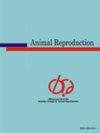Impact of GnRH agonist and GnRH antagonist on GDF9 and BMP15 expression in mouse ovaries and oocyte development
IF 1.6
4区 农林科学
Q2 AGRICULTURE, DAIRY & ANIMAL SCIENCE
引用次数: 0
Abstract
Abstract GnRH analogues were widely used for controlld ovary stimulation, but their effects on oocyte quality remain contradictory. This study aimed to explore the influence of GnRH analogues on oocyte quality in mice. A total of 120 mice were randomly assigned to four groups:(i)GnRH-a+PMSG group; (ii) GnRH-ant+PMSG group; (iii) PMSG group; (iv) Control group. Ovaries were collected for quantitative real-time polymerase chain reaction (qRT-PCR) to assess GDF9 and BMP15 mRNA expression, and protein expression were evaluated by western blotting. Moreover, embryo developmental progress in vitro and implantation rate in vivo were recorded. Compared with control group, both GDF9 mRNA and protein expressions were strengthened in PMSG group, but reduced in the presence of GnRH-a or GnRH-ant. The GnRH-a group exhibited decreased BMP15 mRNA expression compared to PMSG group, while the GnRH-ant group did not show the same pattern. BMP15 protein expression were not statisticlly different among the four groups. Notably, there was no statistically difference in the expression of these two factors between GnRH-a and GnRH-ant groups. The percentage of zygotes progressing to the 2-cell stage and percentage of 2-cell advancing to the blastocyst stage were similar in the PMSG group and control group. However, both the GnRH-a and GnRH-ant groups showed decreased embryos development rates compared to other two groups. The embryonic implantation rate in control group (53.3%) was higher than that in the GnRH-a and GnRH-ant groups (33.3% and 30.8%, P<0.05). The difference between the PMSG (45.0%) and GnRHa group was statistically significant (P value of 0.023), but not between the PMSG and GnRH-ant group (P value of 0.486). No statistical difference was confirmed between GnRH-a and GnRH-ant groups. Our findings shed light on the safety of GnRH analogues in ovary stimulation, and highlight the need for further research to establish optimal and effective controlled ovary stimulation protocol.GnRH 激动剂和 GnRH 拮抗剂对小鼠卵巢中 GDF9 和 BMP15 表达以及卵母细胞发育的影响
GnRH类似物被广泛用于控制卵巢刺激,但其对卵母细胞质量的影响一直存在矛盾。本研究旨在探讨GnRH类似物对小鼠卵母细胞质量的影响。将120只小鼠随机分为4组:(i)GnRH-a+PMSG组;(ii) GnRH-ant+PMSG组;(iii) PMSG组;(iv)对照组。采集卵巢进行实时定量聚合酶链反应(qRT-PCR)检测GDF9和BMP15 mRNA表达,western blotting检测蛋白表达。记录胚胎体外发育过程和体内着床率。与对照组相比,PMSG组GDF9 mRNA和蛋白表达均增强,而GnRH-a和GnRH-ant存在时GDF9 mRNA和蛋白表达均降低。与PMSG组相比,GnRH-a组BMP15 mRNA表达降低,而GnRH-ant组没有表现出相同的模式。四组间BMP15蛋白表达差异无统计学意义。值得注意的是,这两个因子在GnRH-a组和GnRH-ant组之间的表达无统计学差异。PMSG组受精卵进入2细胞期和2细胞进入囊胚期的比例与对照组相似。然而,与其他两组相比,GnRH-a组和GnRH-ant组的胚胎发育率都有所下降。对照组胚胎着床率(53.3%)高于GnRH-a和GnRH-ant组(33.3%和30.8%,P<0.05)。PMSG(45.0%)与GnRHa组的差异有统计学意义(P值为0.023),而PMSG与GnRH-ant组的差异无统计学意义(P值为0.486)。GnRH-a组与GnRH-ant组间无统计学差异。我们的研究结果揭示了GnRH类似物在卵巢刺激中的安全性,并强调需要进一步研究以建立最佳和有效的控制卵巢刺激方案。
本文章由计算机程序翻译,如有差异,请以英文原文为准。
求助全文
约1分钟内获得全文
求助全文
来源期刊

Animal Reproduction
AGRICULTURE, DAIRY & ANIMAL SCIENCE-
CiteScore
2.30
自引率
11.80%
发文量
49
审稿时长
70 days
期刊介绍:
Animal Reproduction (AR) publishes original scientific papers and invited literature reviews, in the form of Basic Research, Biotechnology, Applied Research and Review Articles, with the goal of contributing to a better understanding of phenomena related to animal reproduction.
The scope of the journal applies to students, researchers and practitioners in the fields of veterinary, biology and animal science, also being of interest to practitioners of human medicine. Animal Reproduction Journal is the official organ of the Brazilian College of Animal Reproduction in Brazil.
 求助内容:
求助内容: 应助结果提醒方式:
应助结果提醒方式:


